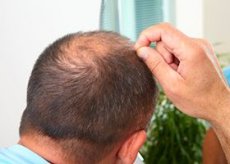Medical expert of the article
New publications
Trichotillomania
Last reviewed: 07.07.2025

All iLive content is medically reviewed or fact checked to ensure as much factual accuracy as possible.
We have strict sourcing guidelines and only link to reputable media sites, academic research institutions and, whenever possible, medically peer reviewed studies. Note that the numbers in parentheses ([1], [2], etc.) are clickable links to these studies.
If you feel that any of our content is inaccurate, out-of-date, or otherwise questionable, please select it and press Ctrl + Enter.

Of all the disorders associated with impulsive actions, trichotillomania and its relationship with OCD have been studied particularly thoroughly. The main manifestations of trichotillomania are:
- repetitive hair plucking;
- the growing internal tension that precedes this action;
- the pleasure or relief that accompanies the action.
Most often, hair is plucked from the head, eyebrows, eyelashes, limbs, and pubis. Some patients eat their hair (trichotillophagia). The patchy areas without hair may become noticeable to others - this forces them to wear a wig or resort to intensive measures to disguise it. After plucking, patients do not feel satisfaction, but rather are concerned about the defect in their appearance or experience dissatisfaction due to the inability to control their actions.
Diagnostic criteria for trichotillomania
- A. Repetitive hair pulling resulting in noticeable hair loss
- B. A growing feeling of tension immediately preceding hair pulling or an attempt to resist the urge to do so.
- B. Feelings of pleasure, satisfaction, or relief after hair plucking
- D. The disturbances are not better explained by another mental disorder or a general medical condition (e.g., a skin disease)
- D. The disorder causes clinically significant discomfort or disrupts the patient's functioning in social, professional or other important areas
Although hair pulling increases during periods of stress, it most often occurs in situations where the sufferer is not actively engaged in activities, such as watching television, reading, or driving home from work. These observations suggest that trichotillomania should be viewed as a pathological habit rather than an impulse control disorder. Habit reversal, a behavioral therapy technique that is most effective for trichotillomania, was first developed to combat pathological habits. Some authors believe that another very common condition, pathological purging, which is characterized by constant removal of dust particles, straightening of a suit, etc., is closely related to trichotillomania, onychophagia, and some forms of OCD.
Despite the similarities, there are also significant differences between trichotillomania and OCD. Although early reports of trichotillomania emphasized that it was comorbid with OCD and responded favorably to SSRIs, more recent studies have shown that trichotillomania often occurs as an independent disorder and that its drug treatment is often ineffective. Unlike OCD, trichotillomania is more common in women than in men. The hypothesis that OCD and trichotillomania share common pathophysiological changes in the brain has been challenged by functional neuroimaging studies that have revealed differences between the two conditions.
Although the efficacy of clomipramine in trichotillomania has been proven in double-blind controlled studies, the efficacy of SSRIs, and especially fluoxetine, has not been confirmed in most controlled studies. Scientists conducted an 8-week open-label study of fluvoxamine (at a dose of up to 300 mg/day) in 19 patients with trichotillomania. As a result, an improvement was noted in 4 of 5 control parameters with a decrease of 22-43% compared with the initial level. However, only in 4 of 19 (21%) patients could the effect be assessed by stricter criteria as clinically significant, and by the end of the 6th month of treatment, the effectiveness of the drug was lost. Even in cases of a good response to SSRIs at the beginning of treatment, spontaneous relapses are often observed in trichotillomania. Additional studies are needed to assess the efficacy of other drugs or a combination of several drugs in the treatment of this complex disease.


 [
[